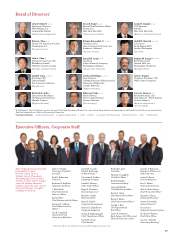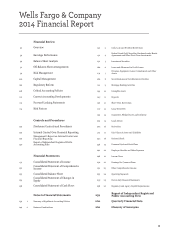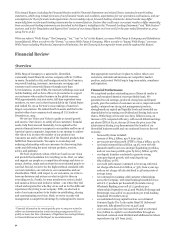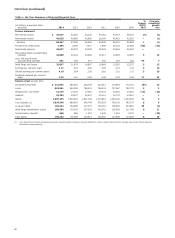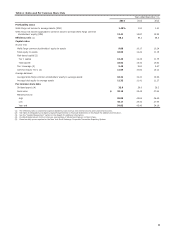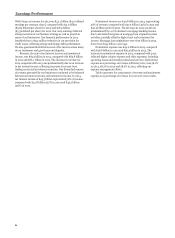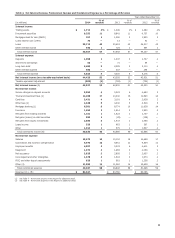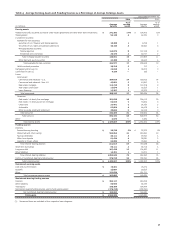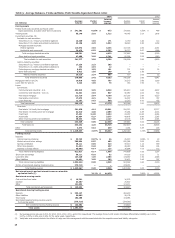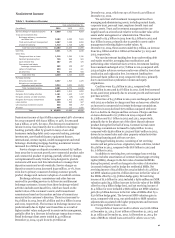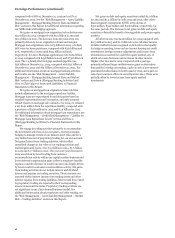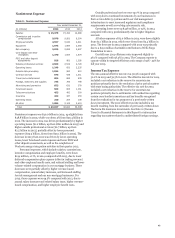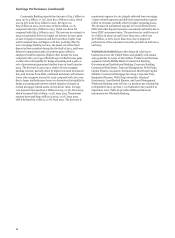Wells Fargo 2014 Annual Report Download - page 38
Download and view the complete annual report
Please find page 38 of the 2014 Wells Fargo annual report below. You can navigate through the pages in the report by either clicking on the pages listed below, or by using the keyword search tool below to find specific information within the annual report.Earnings Performance (continued)
Net Interest Income
Net interest income is the interest earned on debt securities,
loans (including yield-related loan fees) and other interest-
earning assets minus the interest paid for deposits, short-term
borrowings and long-term debt. The net interest margin is the
average yield on earning assets minus the average interest rate
paid for deposits and our other sources of funding. Net interest
income and the net interest margin are presented on a taxable-
equivalent basis in Table 5 to consistently reflect income from
taxable and tax-exempt loans and securities based on a 35%
federal statutory tax rate.
While the Company believes that it has the ability to
increase net interest income over time, net interest income and
the net interest margin in any one period can be significantly
affected by a variety of factors including the mix and overall size
of our earning assets portfolio and the cost of funding those
assets. In addition, some variable sources of interest income,
such as resolutions from purchased credit-impaired (PCI) loans,
loan prepayment fees and collection of interest on nonaccrual
loans, can vary from period to period. Net interest income
growth has been challenged during the prolonged low interest
rate environment as higher yielding loans and securities runoff
have been replaced with lower yielding assets. The pace of this
repricing has slowed in recent quarters.
Net interest income on a taxable-equivalent basis was
$44.4 billion in 2014, compared with $43.6 billion in 2013, and
$43.9 billion in 2012. The net interest margin was 3.11% in 2014,
down 29 basis points from 3.40% in 2013, which was down
36 basis points from 3.76% in 2012. The increase in net interest
income for 2014, compared with 2013, was largely driven by
securities purchases, higher trading balances, and reduced
funding costs due to disciplined deposit pricing and lower long-
term debt yields. Strong growth in commercial, retained real
estate and automobile loans also contributed to higher net
interest income as originations replaced runoff in the non-
strategic/liquidating portfolios. The improvement in net interest
income was partially offset by the impact of lower mortgages
held for sale (MHFS) balances. The decline in net interest
margin in 2014, compared with a year ago, was primarily driven
by higher funding balances, including actions taken in response
to increased regulatory liquidity expectations, which raised long-
term debt and term deposits in addition to customer-driven
deposit growth. This growth in funding increased cash and
federal funds sold and other short-term investments and was
dilutive to net interest margin although essentially neutral to net
interest income.
Table 4 presents the components of earning assets and
funding sources as a percentage of earning assets to provide a
more meaningful analysis of year-over-year changes that
influenced net interest income.
Average earning assets increased $147.3 billion in 2014
from a year ago, as average investment securities increased
$30.6 billion and average federal funds sold and other short-
term investments increased $86.4 billion for the same period,
respectively. In addition, average loans increased $31.8 billion in
2014, compared with a year ago. The increases in average
investment securities, average federal funds sold and other
short-term investments and average loans were partially offset
by a $16.3 billion decline in average MHFS.
Core deposits are an important low-cost source of funding
and affect both net interest income and the net interest margin.
Core deposits include noninterest-bearing deposits, interest-
bearing checking, savings certificates, market rate and other
savings, and certain foreign deposits (Eurodollar sweep
balances). Average core deposits rose to $1.0 trillion in 2014,
compared with $942.1 billion in 2013, and funded 120% of
average loans compared with 117% a year ago. Average core
deposits decreased to 70% of average earning assets in 2014,
compared with 73% a year ago. The cost of these deposits has
continued to decline due to a sustained low interest rate
environment and a shift in our deposit mix from higher cost
certificates of deposit to lower yielding checking and savings
products. About 96% of our average core deposits are in
checking and savings deposits, one of the highest industry
percentages.
Table 5 presents the individual components of net interest
income and the net interest margin. The effect on interest
income and costs of earning asset and funding mix changes
described above, combined with rate changes during 2014, are
analyzed in Table 6.
36



